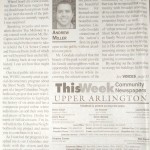ThisWeek UA 3/17/2010
When I heard City Council Member David DeCapua suggest that we should search out private funding to meet the needs of the public amenities we currently support I was surprised. Speaking to Parks and Recreation Director Tim Moloney at a City Council work session Mr. DeCapua felt that private benefactors might be the route to take to rebuild the UA Senior Center and Tremont Pools – both of which are well beyond their useful life.
Looking back at our region’s history I can see how that might work.
Our local public television station, WOSU, recently aired a special documentary program about the Short North. The program is part of a larger Columbus Neighborhoods project which uses television documentaries to highlight the history of six areas and has a companion project online where individuals can add their own bits and pieces of history. [For full disclosure I’m involved in the ColumbusNeighborhoods.org project and invite you to contribute to it too.]
As I watched the program it inspired me to see Columbus residents with the vision and the where-with-all create something unique and community changing both in the early growth of Columbus as well as in neighborhood revitalization efforts.
In those early years of Columbus many of the wealthier families chose to use their resources not just to create beautiful homes for themselves but to also create beautiful communities. Lincoln Goodale created one of the nations first city parks open to the public without an admission price. Mr. Goodale realized that the beauty of the park would provide his family and neighbors with an opportunity for exercise and recreation close to home while increasing the attractiveness of the community he was building. In that way he recognized that a community with broader amenities drove community pride higher and in return drove the value of his properties higher as well.
After several years (decades) of “urban renewal” devastated the Short North, real estate developer Sandy Wood came along and began in earnest to try and revitalize it. His efforts went beyond just investing money in the buildings but also investing his vision of growing a community. By seeking out the creative class to occupy his buildings he let their natural ability to use creative problem solving and collaboration as a way to turn a destitute piece of real estate into a cultural landmark. Mr. Wood connected with this energy and commissioned public art and helped to foster the attractions that most of us enjoy the Short North for today.
Of course these are only two examples of philanthropy that caused a cultural shift within a community. There are however plenty of other examples. Just take a look around at our art museums, parks and sporting fields and you find that philanthropic individuals have provided central Ohio with some of its most beautiful public exhibits of nature, culture and athletics. These are all amenities that I know my family values because they make our lives more complete.
For several years now the community of Upper Arlington has struggled to define how it values its own public spaces; its places of recreation and culture. In that process arguments have occurred over whether or not our master plan is the correct vision for the future of Upper Arlington, how we as residents would like to see development implemented and over what sorts of public institutions we as residents are willing to support with tax revenue.
Sadly in recent times Upper Arlington has benefitted from very few Lincoln Goodales or Sandy Woods.
Instead redevelopment has often butted heads with the master plan because the developers have looked less at the long term investment in community and more at the short term bottom line. This might be a requirement of their incorporation or they might just be taking their lead from the voters of Upper Arlington. The voters have defeated recent capital improvement projects such as the Tremont Library update and the multiple attempts at a community center as well as many have fought fervently against other redevelopment projects and infrastructure investments.
So let’s ask ourselves these questions: what if I was a wealthy benefactor interested in investing in my community? What would make me want to put my name upon something? What would make me want to leave my mark?
The Upper Arlington Foundation is struggling with just that very question as it tries to fund the raising of the historical barn at Sunny 95 Park. As our UA Senior Center falls into obsolescence and the Tremont Pools require more and more patching are we as a whole community showing those possibly philanthropists we care enough to deserve their charity?
More to the point, are we so unwilling as taxpayers to invest in these resources that we require such charity?

